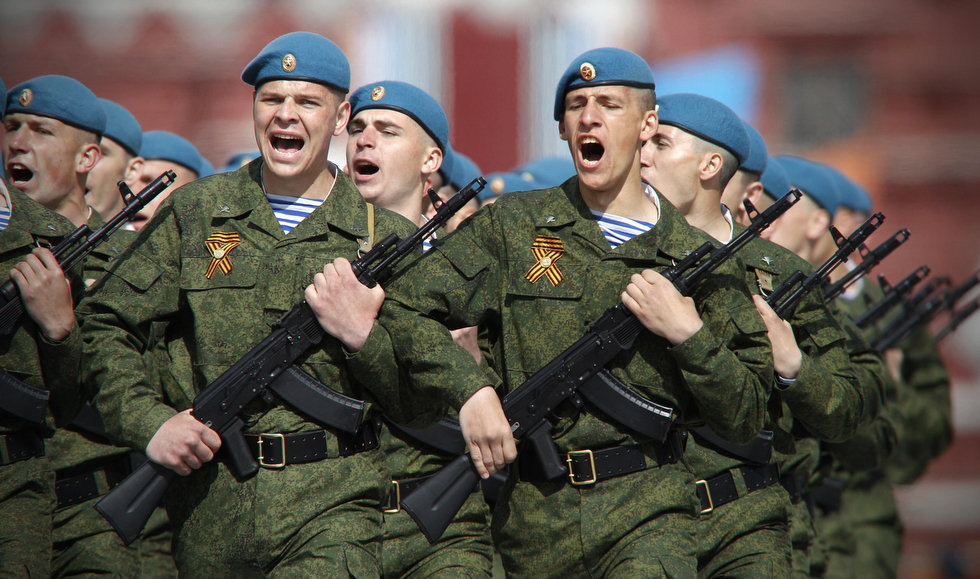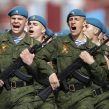
Russia’s Elite Airborne Forces Celebrate VDV Day
Publication: Eurasia Daily Monitor Volume: 11 Issue: 143
By:

The annual celebration of Russia’s elite Airborne Forces (Vozdushno Desantnye Voyska—VDV) on August 2, 2014, combined shows of strength with loutish behavior. Traditional displays of strength range from breaking bricks on VDV personnel, hand-to-hand combat and other macho shows. Celebration is less restrictive, especially among the veterans, involving frolicking in fountains, consuming large quantities of vodka and a general drunken frenzy. The celebration of the 84th anniversary of creating the force—today 35,000 strong and lightly armed—has particular resonance among its personnel. Notably, the elite paratroopers were involved in the annexation of Crimea. And they continue to receive increased numbers of contract personnel and modern hardware, included in the concept of developing the country’s rapid reaction forces. In late June, the VDV staged a divisional and brigade level air re-deployment of over 3,500 miles. For Airborne Forces personnel, there is an air of expectancy that good times are ahead (Nezavisimoye Voyennoye Obozreniye, August 1).
In a range of interviews to mark VDV Day, Colonel-General Vladimir Shamanov, the Commander of the VDV, highlighted the continued transformation of the force. He also praised the performance of the VDV in reclaiming Crimea, and drew a distinction between the use of Russian paratroopers and the alleged involvement of Ukrainian paratroopers in attacking civilians in eastern Ukraine. Significantly, he referred to recent hardware procurement in the Airborne Forces, the numbers of vehicles arriving in his units, as well as plans for the use of more unmanned aerial vehicles (UAV) and other features of this force transformation. Shamanov explained that this is designed to fit more broadly into the concept of the rapid reaction forces (Krasnaya Zvezda, August 2).
Indeed, according to Shamanov, state testing on the fleet of future tracked combat vehicles and other types of hardware for the VDV continues, and shows some signs of progress. “It is planned that the testing of two BMD-4M airborne combat vehicles and two BTR-MDM airborne armored personnel carriers will be completed by December 1,” he explained. The VDV commander further stated that state tests for armored vehicles for the Armed Forces are 56 percent complete, and combat vehicles for the Airborne Forces reached 51 percent. “In accordance with the signed state contracts with OAO [Open Joint-Stock Company] Kurganmashzavod [Kurgan Machine Building Plant], eight BTR-MDMs and eight BMD-4Ms (a company set) have been produced,” said Shamanov. In March, eight BTR-MDMs were delivered to the 51st Parachute Assault Regiment of the 106th Airborne Division (Tula), and in early July another eight BMD-4Ms were delivered to the 137th Regiment of the 106th Division (Ryazan). “The preparatory measures that have been conducted will allow a monitored troop exploitation program of the new equipment under planned combat training conditions to be effectively executed,” he noted (Rossiya 24 TV, August 1, July 31).
Shamanov boasted that the VDV is creating a modern force of what society refers to as “polite people,” with strong emphasis placed upon education, training, and introducing modern weapons and equipment. He also noted that the VDV will receive 64 BMD-4M airborne infantry fighting vehicles next year. “We plan to get two battalion-size sets of 32 BMD-4M vehicles and over 20 Rakushka armoured personnel carriers,” he said, highlighting the VDV tests of these assets since February 2014. BMD-1s have been upgraded for the VDV to the BMD-2 standards. The VDV received 120 of 212 units of such upgrades: battalion sets for the 76th Airborne Assault division, the 106th Airborne Division, the 56th Airborne Assault Brigade, and the 7th Airborne Assault Division (the latter is being fully outfitted) (Rossiya 24 TV, August 1, July 31).
Russian media reported in late June that during a “snap inspection” of Central Military District forces, involving more than 65,000 personnel, the VDV was subject to a test of its strategic mobility. Military Transport Aviation conducted 96 sorties to allegedly redeploy a VDV division and brigade to the training area. It is likely that the full complement of the division was not deployed, but the mobility demonstrated that the VDV can be inserted at particularly short notice and with relative ease over considerable distance. No doubt this “threat” remains a real tool as the Kremlin tries to leverage its longer-term interests in Ukraine; any future peacekeeping operation in the country would certainly involve elements of the VDV (Rossiya 24 TV, June 28).
These equipment upgrades and procurement of new assets undoubtedly contributes to increased morale and a sense in the VDV that their interests are being taken seriously by the Ministry of Defense. Nevertheless, Shamanov sees this as part of a long-term process, unlikely to reach its completion until around 2025. Underlying the existing plans to upgrade and introduce modern hardware is a vision for the VDV that places the force at the heart of the evolving rapid reaction forces (Krasnaya Zvezda, August 2). The defense ministry was openly discussing the formation of this new force structure prior to the operation to annex Crimea, and it appears to be waiting for approval to formally announce its existence. However, Shamanov’s thinking on VDV development is clearly influenced by the whole idea that Russia is forming new rapid reaction forces for various mission types.
Shamanov retains a reputation among military personnel as a tough and competent officer. Moreover, his well-publicized friendship with President Vladimir Putin is politically important at a time when Putin needs vital support from within the military for his strategy in Ukraine. Although Shamanov has sheltered the VDV in recent years from the reforms and experiments impacting on the wider Armed Forces, he has also shown determination to promote the VDV’s interests at the highest levels (RT, August 1).
However, the VDV’s role in annexing Crimea, its progress in recent exercises in terms of mobility, and greater levels of equipment modernization, combined with its central role in the concept for the rapid reaction forces, should not imply that all is well or that we are witnessing a revolutionary change in Russian approaches to warfare. Change is certainly present, but in the VDV as elsewhere in the Russian military this fits a pattern of experiment and trying to make the best with what exists. Shamanov’s influence in recent years, in addition to the various advances involved, will serve to ensure that the VDV will never be far from future Russian conflicts.




